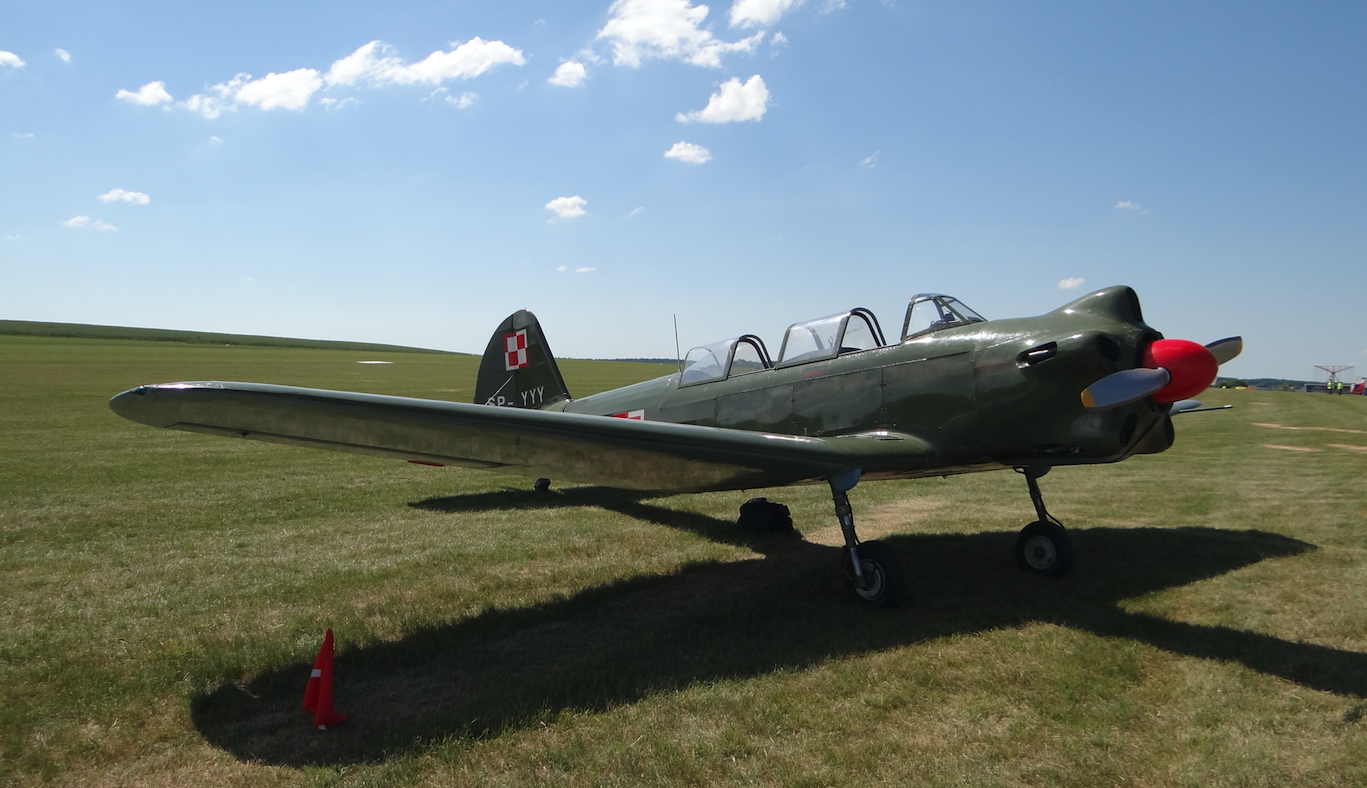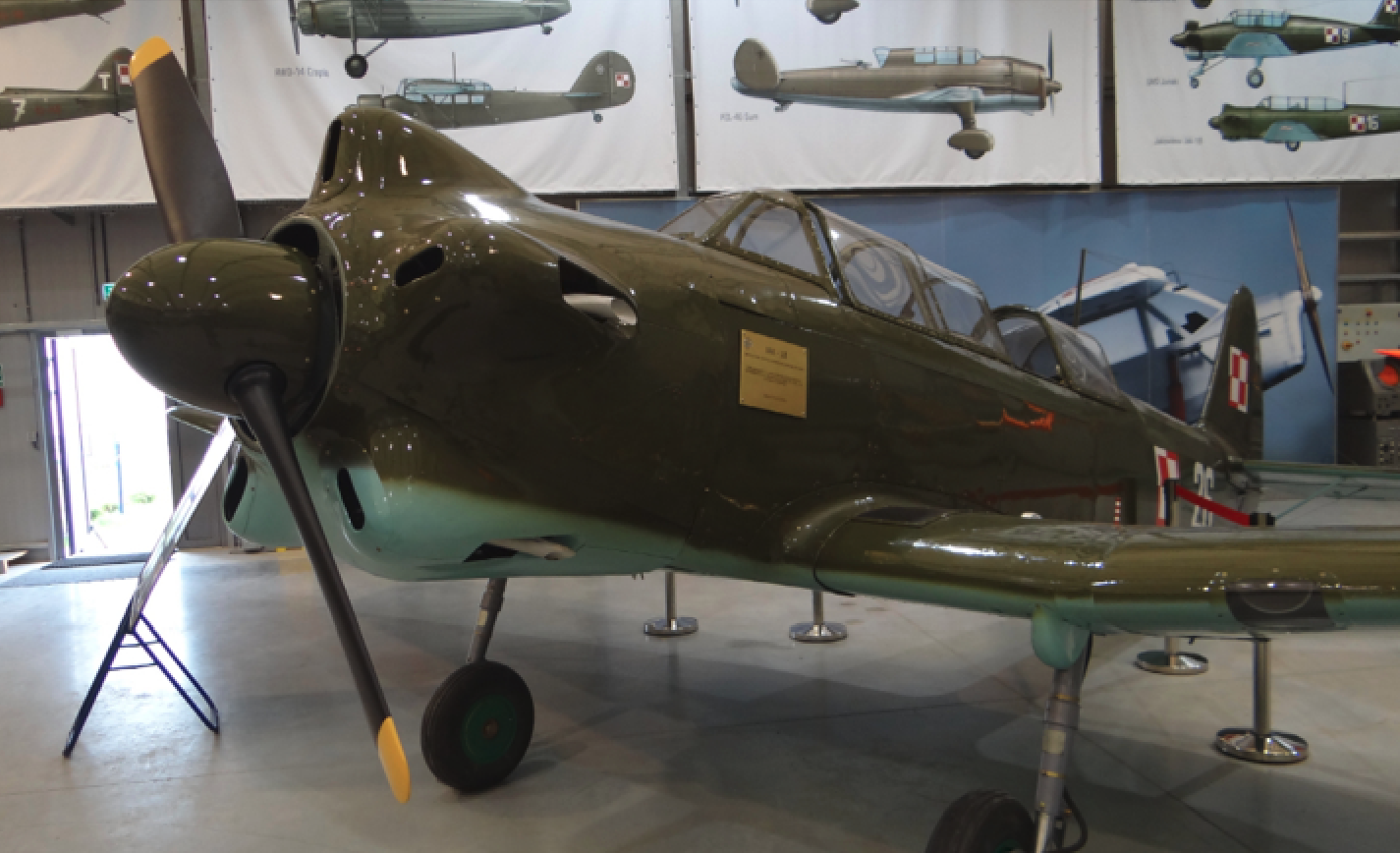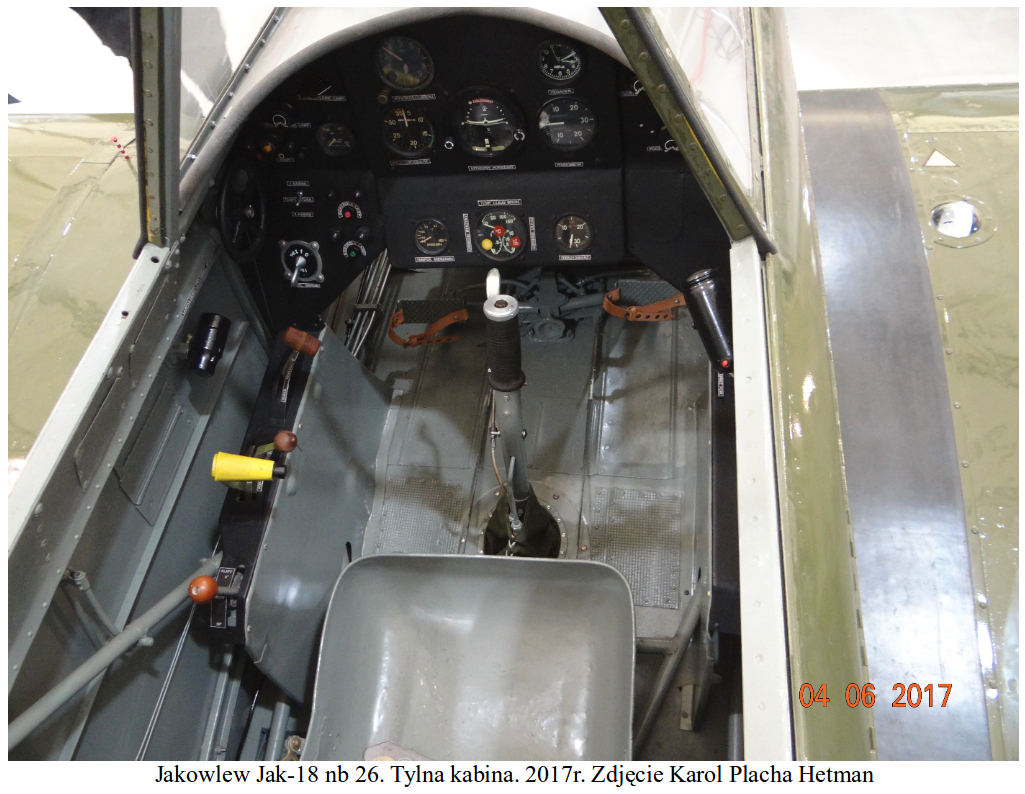Kraków 2017-05-19
History
Jak-18 in Poland.
The training and training planes Jakowlew Jak-18 arrived in Poland on September 1, 1951.


The Soviet Yakovlev UT-2 plane was a bad training and training plane. He was difficult to pilot and did not forgive mistakes. Engineer Tadeusz Sołtyk even described it as dangerous and claimed that it is not necessary to select pilots through the cemetery. In 1943, the OKB Yakovlev office developed several designs to modify the UT-2 aircraft. However, the work took a long time due to other more urgent tasks of the office. At the end of 1945, these constructions were tested and, on the basis of the results, the development of a new one, designated Jak-18, was started. The Yak-18 initially had a fixed landing gear. The crew cabin was completely glazed. The plane was powered by the M-11 E engine, 107 kW (145 HP). However, due to the low quality of the engines built, their power slightly exceeded 100 HP.
In 1946, the improved Yak-18 aircraft was tested. The main changes were the use of the more powerful M-11 Fr engine with 118 kW (160 HP). In theory, the airframe was to be prepared for the use of a 300 HP engine, which happened in 1957. As a result, the Jak-50, Jak-52 aerobatic planes were created.
Another change was the use of a retractable landing gear. The mechanism was very simple and did not completely hide the wheels in the fuselage. The main goal was not to achieve high speed by the plane, but to make pilots the habit of retracting and extending the landing gear, because all new combat aircraft already had retractable landing gear. This design solution had a significant advantage. When the pilot forgot to extend the landing gear during landing, the structure of the aircraft was not completely destroyed. Only the propeller was destroyed.
Factory and state trials of the Yak-18 were carried out in 1946. At the beginning of 1947, the plane was approved for serial production. It was a very urgent matter, because the UT-2 planes quickly fell out of service. Production was launched at the Aviation Plant No. 135 in Kharkiv, Ukraine. Later, the Kharkov plant was known for the production of aircraft with the Antonov logo. The first production series of the Yak-18 aircraft was completed in 1947. A little later, production was also started at the Arseniewskie Zakłady Lotnicze "Progress" in Arseniewo, almost on the Japanese Sea. In 1953, the production of the Yak-18, under the designation BT-3 (CJ-1), was launched by China, and in 1956 by Hungary. About 5,400 - 5,680 copies were built at CCCP. In total, around 7,000 machines were built by 1960.
The Yak-18 aircraft quickly became a training aircraft in the CCCP air force and in the DOSAAF (Voluntary Association for Cooperation with the Army, Aviation and Fleet). Yak-18 planes were operated in such countries as: China, Hungary, Albania, Afghanistan, Austria, Bulgaria, North Korea, East Germany, Romania, CCCP, Poland. The Yak-18 aircraft turned out to be easy to pilot and easy to operate.
In 1957, a version of the Yak-18 A with a radial engine, 9-cylinder, AI-14R with 191 kW (260 HP) was created. On the basis of this version, an aerobatic version was created, which received a chassis with a front wheel. A few more versions were built in small series. The aerobatic versions were the progenitors of the Jak-50 (1974) and the Jak-52.
Yak-18 in Poland.
The Jak-18 plane was presented in Poland at the XXI Poznań International Fair, from April 24, 1948 to May 9, 1948. The plane was presented at Ławica Airport together with the Ił-12 passenger plane. Both planes were an export proposal for Poland. At that time, decisions were already made to purchase the Jak-18 planes for the School of Eaglets in Dęblin. The first delivery consisted of 15 pieces. The planes were produced in 1949 and 1950. They were entered into the state in September 1951. In Dęblin, the Jak-18 planes were directed to the 7th Basic Training Squadron in Radzyń Podlaski. Some of the machines were permanently based in Dęblin. The purchase of Jak-18 planes for the School in Radom is also planned. The machines were delivered to Radom in August 1952. The Polish Army purchased a total of 55 machines, in four batches (15, 20, 10, 10). In 1951, several aircraft went to the Aero Clubs to train candidates for military aviation schools.
In Poland, the Yak-18 aircraft competed with the domestic LWD Junak-2 design. However, it was more political than substantive competition. Purchases of subsequent batches of Yak-18 planes in 1952 were motivated by the high demand for this type of aircraft. However, already in 1953, the planes were transferred to the state of combat units as liaison, dispatch and training planes. At that time, the Yak-18 was no longer suitable as a basic training aircraft due to the lack of a front-wheel landing gear, which was required to train pilots for MiG-15 and Lim-1 aircraft. The introduction of the TS-9 Junak-3 with a front wheel was more advantageous, even though it did not have a retractable landing gear. It was a compromise fully accepted by the Polish Army.
At the end of 1954, Yak-18 planes from combat units began to return to aviation schools. The reason was the purchase of a batch of Yak-11 aircraft, which replaced the Yak-18 from linear units. The Jak-18 planes were entered into the status of the 5th School Aircraft Squadron and the 6th School Aircraft Squadron. A little later, after the reform of training units, the Yak-18 planes were also delivered to: 52nd Air Training Regiment in Radzeń Podlaski, 59th Air Training and Combat Regiment in Biała Podlaska, 24th Reserve Pilot Training Squadron in Ułęż. From 1957, Yak-18 planes were withdrawn from military units and transferred to Aero Clubs. They were replaced by PZL TS-8 Bies. Few copies of the Yak-18 survived until the 1980s. Currently (2017), there is one copy of the Yak-18, registration SP-YYY, which is a flying exhibit.
Construction
Construction Jakowlew Jak-18.


The Jakowlew Jak-18 plane is a single-engine, two-seat, low-wing, classic layout, intended for basic training. Metal structure (duralumin) covered with canvas.
Straight wings, trapezoidal outline with rounded ends. Two-girder construction. The wings consist of three parts. The wings are covered with sheet metal from the leading edge to the front spar. Duralumin slotted ailerons covered with linen. The dural crocodile flaps fit only under the central wing.
Classic fuselage made of metal, covered with linen. The fuselage is a spatial truss welded from steel pipes, profiled with wooden slats. The front part of the fuselage is covered with sheet metal. Some planes had shielded engine cylinders, and some had bare cylinders. Everything depends on the climate in which the aircraft was to be operated. The cabin is fully glazed.
Classic, metal, linen-covered tail. Tail with the division into rudders and ballasts. The tail end was supported with struts, and the tail end was stiffened with steel wire tendons. Two-spar horizontal stabilizer, not divided. The stabilizer is covered with cloth, only from the leading edge to the front spar is covered with duralumin. The elevator, two-part, all-metal structure, covered with linen. The vertical stabilizer was identical to the horizontal one. The rudder of a metal structure covered with linen.
Chassis with tail wheel. The main landing gear is partially retractable into the wings.
Engine.
M-11 Fr five-cylinder star engine with 118 kW (160 HP). A propeller with variable pitch of the blades.
Equipment.
Short-wave radio (KF), which included the RSI-6K transmitter and the RSI-6M receiver as well as the RPKO-10M radio semi-compass and the telephone on board the SPU. The plane is equipped for night flights.
Data T-T Jak-18:
Span 10.62 m. Length 8.03 m. Height 2.09. The bearing area is 17.0 m2. Curb weight 805 kg. Gross weight is 1,165 kg. Top speed 248 km / h. Cruising speed 160-215 km / h. The maximum range is 850 km. Service ceiling is 3,000 m.
Tally
Jakowlew Jak-18 in Poland. 1951.
In the years 1951-1958, 55 machines Jak-18 were used in the Polish Army.
Written by Karol Placha Hetman
